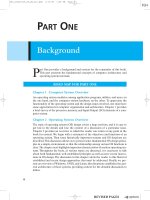Operating system internal and design principles by williams stallings chapter 012
Bạn đang xem bản rút gọn của tài liệu. Xem và tải ngay bản đầy đủ của tài liệu tại đây (532.25 KB, 78 trang )
File Management
Chapter 12
1
File Management
• File management system consists of system
utility programs that run as privileged
applications
• Input to applications is by means of a file
• Output is saved in a file for long-term storage
2
File System Properties
• Long-term existence
• Sharable between processes
• Structure
3
File Operations
•
•
•
•
•
•
Create
Delete
Open
Close
Read
Write
4
Terms Used with Files
• Field
– Basic element of data
– Contains a single value
– Characterized by its length and data type
• Record
– Collection of related fields
– Treated as a unit
• Example: employee record
5
Terms Used with Files
• File
– Collection of similar records
– Treated as a single entity
– Have file names
– May restrict access
• Database
– Collection of related data
– Relationships exist among elements
6
Typical Operations
•
•
•
•
•
•
•
•
Retrieve_All
Retrieve_One
Retrieve_Next
Retrieve_Previous
Insert_One
Delete_One
Update_One
Retrieve_Few
7
File Management Systems
• The way a user of application may access files
• Programmer does not need to develop file
management software
8
Objectives for a
File Management System
• Meet the data management needs and
requirements of the user
• Guarantee that the data in the file are valid
• Optimize performance
• Provide I/O support for a variety of storage
device types
9
Objectives for a
File Management System
• Minimize or eliminate the potential for lost or
destroyed data
• Provide a standardized set of I/O interface
routines
• Provide I/O support for multiple users
10
Minimal Set of Requirements
• Each user should be able to create, delete,
read, write and modify files
• Each user may have controlled access to other
users’ files
• Each user may control what type of accesses
are allowed to the users’ files
• Each user should be able to restructure the
user’s files in a form appropriate to the
problem
11
Minimal Set of Requirements
• Each user should be able to move data
between files
• Each user should be able to back up and
recover the user’s files in case of damage
• Each user should be able to access the user’s
files by using symbolic names
12
13
Device Drivers
• Lowest level
• Communicates directly with peripheral devices
• Responsible for starting I/O operations on a
device
• Processes the completion of an I/O request
14
Basic File System
•
•
•
•
Physical I/O
Deals with exchanging blocks of data
Concerned with the placement of blocks
Concerned with buffering blocks in main
memory
15
Basic I/O Supervisor
• Responsible for file I/O initiation and
termination
• Control structures are maintained
• Concerned with selection of the device on
which file I/O is to be performed
• Concerned with scheduling access to optimize
performance
• Part of the operating system
16
Logical I/O
• Enables users and applications to access
records
• Provides general-purpose record I/O capability
• Maintains basic data about file
17
Access Method
• Reflect different file structures
• Different ways to access and process data
18
19
File Management Functions
• Identify and locate a selected file
• Use a directory to describe the location of all
files plus their attributes
• On a shared system describe user access
control
• Blocking for access to files
• Allocate files to free blocks
• Manage free storage for available blocks
20
Criteria for File Organization
• Short access time
– Needed when accessing a single record
– Not needed for batch mode
• Ease of update
– File on CD-ROM will not be updated, so
this is not a concern
21
Criteria for File Organization
• Economy of storage
– Should be minimum redundancy in the data
– Redundancy can be used to speed access
such as an index
• Simple maintenance
• Reliability
22
File Organization
• The Pile
– Data are collected in the order they arrive
– Purpose is to accumulate a mass of data and
save it
– Records may have different fields
– No structure
– Record access is by exhaustive search
23
Pile
24
File Organization
• The Sequential File
– Fixed format used for records
– Records are the same length
– All fields the same (order and length)
– Field names and lengths are attributes of the
file
– One field is the key filed
• Uniquely identifies the record
• Records are stored in key sequence
25









